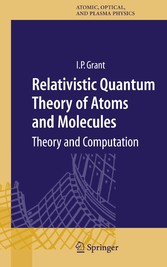Suchen und Finden
Preface
7
Contents
10
Part I Relativity in atomic and molecular physics
23
1 Relativity in atomic and molecular physics
24
1.1 Elementary ideas
24
1.2 The one-electron atom
28
1.3 Many-electron atoms
40
1.4 Applications to atomic physics
61
1.5 Relativistic molecular structure
66
References
75
Part II Foundations
81
2 Relativistic wave equations for free particles
82
2.1 The special theory of relativity
82
2.2 The Lorentz group
85
2.3 The Poincar ´ e group
92
2.4 The Klein-Gordon equation
100
2.5 The Dirac equation
105
2.6 Maxwell’s equations
115
2.7 Symmetries and local conservation laws
122
2.8 Global conservation laws
126
2.9 Green’s functions
127
References
138
3 The Dirac Equation
140
3.1 Free particles
140
3.2 Spherical symmetry
151
3.3 Hydrogenic atoms
162
3.4 Scattering by a centre of force
171
3.5 Relativistic quantum defect theory
180
3.6 Green’s functions
185
3.7 The nonrelativistic limit: the Pauli approximation
192
3.8 Other aspects of Dirac theory
197
References
197
4 Quantum electrodynamics
199
4.1 Second quantization
199
4.2 Quantization of the electron-positron .eld
207
4.3 Quantization of the Maxwell .eld
214
4.4 Interaction of photons and electrons
218
4.5 Wick’s theorems
224
4.6 Propagators
226
4.7 The S-matrix
235
4.8 Bound states
236
4.9 E.ective interactions
240
4.10 Off-shell potentials
246
4.11 Many-body perturbation theory
250
4.12 MBPT for atoms and molecules
254
4.13 Relativistic approaches to atomic and molecular structure
256
4.14 A strategy for atomic and molecular calculations
261
4.15 Density functional theories
263
References
271
Part III Computational atomic and molecular structure
275
5 Analysis and approximation of Dirac Hamiltonians
276
5.1 Self-adjointness of free particle Hamiltonians
277
5.2 Self-adjointness of Hamiltonians with a local potential
279
5.3 The radial Dirac di.erential operator
282
5.4 The radial Dirac equation for atoms
287
5.5 Variational methods in quantum mechanics
291
5.6 The Rayleigh-Ritz method in relativistic quantum mechanics
302
5.7 Spinor basis sets
307
5.8 L-spinors
310
5.9 S-spinors
320
5.10 G-spinors
322
5.11 Finite di.erence methods
324
5.12 Finite element methods
332
References
339
6 Complex atoms
342
6.1 Dirac-Hartree-Fock theory
342
6.2 One-electron matrix elements of tensor operators
344
6.3 Angular reduction of the Dirac Hamiltonian for a central potential
348
6.4 Matrix elements of 2-body operators
350
6.5 Interaction strengths for the magnetic interactions
357
6.6 Closed shells and con.guration averages
363
6.7 DHF integro-di.erential equations
369
6.8 Con.gurations with incomplete subshells
378
6.9 Atoms with complex con.gurations
393
6.10 CI and MCDHF problems with large CSF sets
401
References
408
7 Computation of atomic structures
410
7.1 Atomic structure calculations with GRASP
410
7.2 GRASP modules
411
7.3 MCDHF integro-di.erential equations
415
7.4 Solving the integro-di.erential equations
418
7.5 Starting the calculation
420
7.6 An EAL calculation
424
7.7 Diagonal and o.-diagonal energy parameters
425
7.8 Koopmans’ theorem and Brillouin’s theorem
428
7.9 Control of MCSCF iterations
433
7.10 Corrections to the Coulomb interaction: Breit and other approximations
435
7.11 QED corrections
436
7.12 Towards higher quality atomic models
440
7.13 X-ray transition energies
445
References
448
8 Computation of atomic properties
450
8.1 Relativistic radiative transition theory
450
8.2 Emission and absorption by one-electron atoms
454
8.3 Radiative transitions in many-electron atoms
460
8.4 Orbital relaxation
461
8.5 Application to atomic transition calculations
465
8.6 Relativistic atomic photo-ionization theory
469
8.7 Hyper.ne interactions
476
8.8 Isotope shifts
481
References
484
9 Continuum processes in many-electron atoms
487
9.1 Relativistic elastic electron-atom scattering
487
9.2 Electron-atom scattering: the close-coupling method
493
9.3 The relativistic R-matrix method
496
9.4 The Buttle correction
508
9.5 R-matrix theory of photo-ionization
509
9.6 The DARC relativistic R-matrix package
510
9.7 Truncation of the close-coupling expansion. The nonrelativistic CCC method
512
9.8 The R-matrix method at intermediate energies
516
9.9 Electron scattering from heavy atoms and ions
520
9.10 The relativistic random phase approximation
529
9.11 RRPA rates for photo-excitation and photo- ionization
536
9.12 Comparison with experiment
539
References
545
10 Molecular structure methods
549
10.1 Molecular and atomic structure methods
549
10.2 Dirac-Hartree-Fock-Breit equations for closed shell atoms
551
10.3 One-centre interaction integrals
555
10.4 Numerical examples
557
10.5 The DHFB method for closed shell molecules
559
10.6 G-spinor basis functions
560
10.7 The charge-current density
561
10.8 Two-centre overlaps
562
10.9 Multi-centre interaction integrals
565
10.10 Fock matrix in terms of G-spinors
574
10.11 Electromagnetic .eld energy
578
10.12 Relativistic density functional calculations
584
10.13 Computational strategies
590
10.14 Multicon.gurational Dirac-Hartree-Fock theory
594
References
600
11 Relativistic calculation of molecular properties
602
11.1 Molecular symmetry
602
11.2 Relativistic e.ects in light molecules
609
11.3 Electromagnetic properties of atoms and molecules
616
11.4 The Zeeman e.ect
618
11.5 Hyper.ne interactions
621
11.6 NMR shielding in small molecules
624
11.7 Molecules with high-Z constituents
628
References
639
A Frequently used formulae and data
642
A.1 Relativistic notation
642
A.2 Dirac matrices
643
A.3 Special functions
646
A.4 Central .eld Dirac spinors and their interactions
651
A.5 Open shells in jj-coupling
666
A.6 Exponents for atomic and molecular G-spinors
669
A.7 Software for relativistic molecular calculations
677
References
679
B Supplementary mathematics
680
B.1 Linear operators on Hilbert space
680
B.2 Lie groups and Lie algebras
688
B.3 Quantum mechanical angular momentum theory
698
B.4 Relativistic symmetry orbitals for double point groups
732
B.5 Basis sets in atomic and molecular physics
737
B.6 Finite di.erence methods for Dirac equations
748
B.7 Eigenfunction expansions for the radially reduced Dirac equation
772
B.8 Iterative processes in nonlinear systems of equations
784
B.9 Lagrangian and Hamiltonian methods
787
B.10 Construction of E coefficients
792
References
798
Index
801
Alle Preise verstehen sich inklusive der gesetzlichen MwSt.








